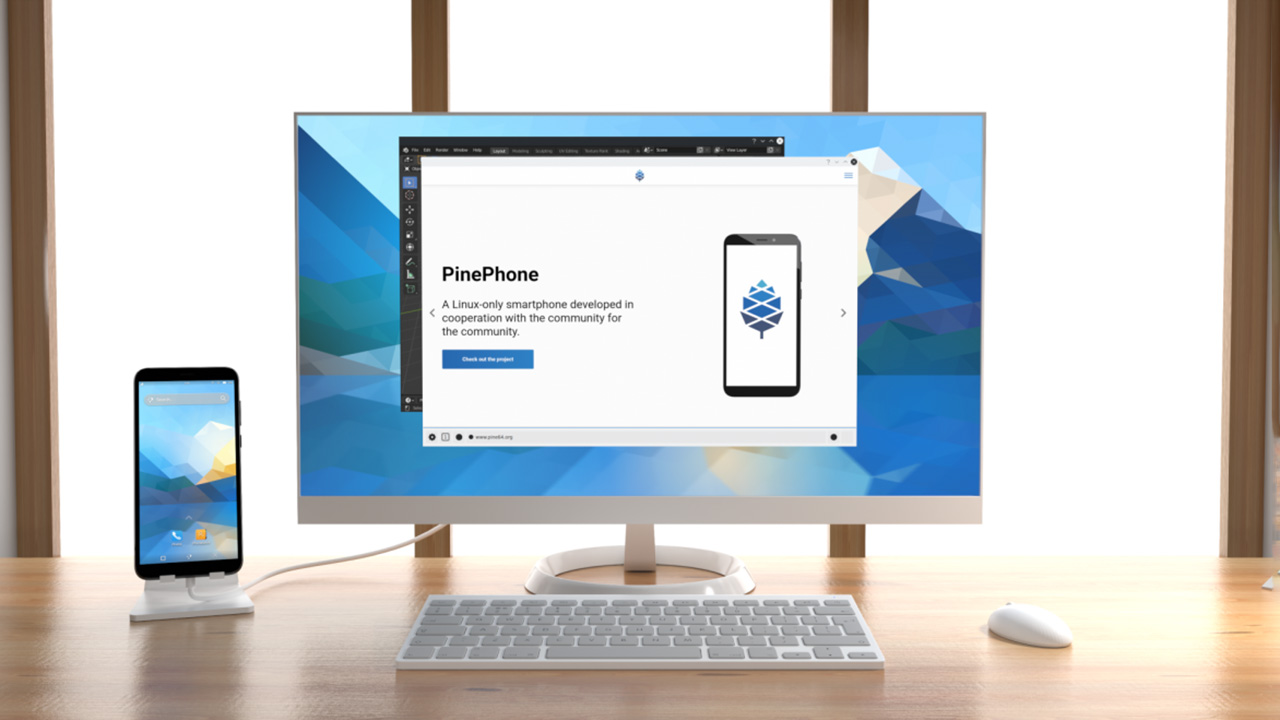Pine64 Announces Updated PinePhone Pro Linux Powered Cell Phone
The desktop in your pocket
Pine64 today announced its latest Linux-powered device, the PinePhone Pro, an update to the original PinePhone which sees a more powerful device running mainline Linux (Manjaro in this case) on a mobile device that works as a cell phone and a desktop computer.
This combination of hardware and software makes the still slightly futuristic idea of confluence between mobile and desktop devices seem a step closer. Carry it around with you, and it’s a phone. Plug it into a monitor, and it’s a desktop PC. The KDE Plasma Mobile front-end adapts to the circumstances.
This isn't Pine64's first mobile Linux device, the original PinePhone was released in July 2020 and has seen much interest from the Linux community who have used it for a diverse range of projects, including some light system administrator work.
| Header Cell - Column 0 | PinePhone Pro | PinePhone |
|---|---|---|
| CPU | Rockchip RK3399S with 2x A72 and 4x A53 CPU cores @ 1.5GHz | Quad-Core Allwinner A64 @ 1.152 GHz |
| RAM | 4GB LPDDR4 @ 800MHz | Up to 3GB LPDDR3 RAM |
| Storage | 128GB eMMC flash storage | Bootable microSD and 16GB/32GB eMMC |
| Screen | 6 Inch 1440 x 720 in-cell IPS | 5.95 Inch 1440 x 720 Resolution IPS Display |
| Connectivity | Wi-Fi ac | Wi-Fi b/g/n |
| Row 5 - Cell 0 | LTE / WCDMA / GSM | LTE / WCDMA / GSM |
| Row 6 - Cell 0 | Bluetooth 4.1 | Bluetooth 4.0 |
| Camera | 13MP Sony IMX258 main camera | Main Camera: Single 5MP, LED Flash |
| Row 8 - Cell 0 | 5MP OmniVision OV5640 front-facing camera | Selfie Camera: Single 2MP |
| Battery | Samsung J7 form-factor 3000mAh | Removable Li-Po 2750-3000 mAh battery |
| Dimensions | 160.8 x 76.6 x 11.1mm | 160.5 x 76.6 x 9.2mm |
Inside, it’s much like any other phone, with a Rockchip RK3399S six-core SoC operating at 1.5GHz, 4GB of dual-channel LPDDR4 RAM, and 128GB of internal eMMC flash storage. It features a 13MP main camera sensor and a 5MP front-facing camera. There's a Micro-SD slot for expanded storage, and a six-inch 1440 x 720 IPS touchscreen. The PinePhone Pro is not a typical cell phone, rather the concept of convergence, the ability to use your phone as a computer is intriguing. Plug your PinePhone Pro into an external display and use it as a low-power desktop computer is something that has been attempted by a number of companies, including Canonical's attempt with Ubuntu Edge.
PinePhone Pro offers something that is missing from the majority of phones, privacy. A series of hardware DIP-switches, hidden under a rear cover, cut off access to the cameras, microphone, Wi-Fi 5 and Bluetooth 4.1 chips, headphone jack, and LTE modem (including GPS) should you ever need to. The layout and Pogo Pins of the new phone are identical to the original PinePhone, so all existing accessories should work.




Retailing at $399, the PinePhone Pro’s makers are realistic about the challenges of putting desktop Linux on a mobile device, especially in an ecosystem dominated by iOS and Android. “Contemporary mobile Linux operating systems have a way to go before they can be considered true alternatives to Android or iOS,” they say in a statement accompanying the announcement. “While mobile Linux isn’t in a state that could satisfy most mainstream electronics consumers, we recognize that a sizable portion of our community is ready to make the jump to a Linux-only smartphone today. The PinePhone Pro has the raw horsepower to be your daily driver, granted you’re ready to accept the current software limitations.”
It’s an interesting glimpse of a possible future, one already being explored by Samsung’s DeX mode and Android’s built-in (but often not activated) desktop environment. It’s encouraging that the original PinePhone was enough of a success to warrant an upgraded version being released, and we look forward to getting things such as more RAM, and a higher-resolution screen, in the future.
Get Tom's Hardware's best news and in-depth reviews, straight to your inbox.

Ian Evenden is a UK-based news writer for Tom’s Hardware US. He’ll write about anything, but stories about Raspberry Pi and DIY robots seem to find their way to him.
-
Sleepy_Hollowed Their devices are great, but the main issue keeping them down is mobile providers, who often if not always in USA limit which phones you can use their sim cards with.Reply
I'd recommend getting into their extensive KB about that before you get one, in USA it is a very limited number of carriers, and even then, you need another device sometimes to activate it.
I would not be surprised if they close it off entirely in USA so that only their phones can be used.
